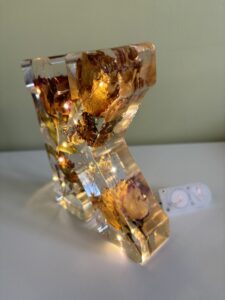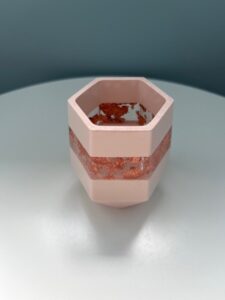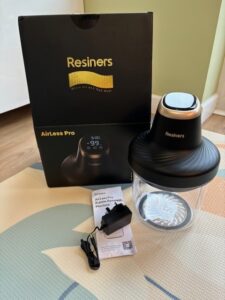Resin terminology explained
Are you baffled by some of the terms you see being used when it comes to crafting with resin? We’ve listed some of the most common terms below with an explanation of what they each mean.
Have we missed any? Let us know in the comments and we will make sure we add them in.
– Amine blush
This is a cloudy waxy surface that appears on the top of your cured resin. This usually happens when there is moisture in the air. We talk about how to prevent this and what to do if it happens, later on.
See our blog on amine blush to find out how to prevent it and what to do if it happens to you.
– Bezel
A jewellery finding with a rim that can hold resin. You may have open or closed back bezels. They are commonly made from plastic or metal and you can pour resin directly in to them.
– Casting
The process of pouring resin into a mould.
– Cure
The process of your resin hardening to become a solid.
– Cure temperature
The ideal temperature required for your resin to cure. This may vary depending on type of resin to use and your chosen resin brand.
– Cure time
The amount of time it takes for the epoxy to turn from a liquid to a solid.
– Degassing
The process of getting bubbles out of your mixed epoxy resin.
– Demoulding
The process or removing your cured resin from its mould.
– Demoulding time
The amount of time you need to wait before you can remove your resin from its mould. This may be before it is fully cured and solid. You can remove resin that is still flexible after a certain time to mould it into certain shapes. For example, if you are creating a bowl.
– Doming
Doming is a way of finishing your rein where you give a domed effect with smooth edges without resin flowing over the edges of your project. Usually, you will use a highly viscous resin like a top coat epoxy or a UV resin.
– Flood coat
Usually your final coat, a flood coat will ensure you have a smooth and glossy finish to your project. You may use a flood coat after sanding or once you have removed your project from a mould and would like to achieve smooth edges.
– Flash cure
The term used for resin that heats and cures quicker than it should. Your resin may become hot or bubble and cure within minutes.
Check out our blog on flash cures.
– Findings
Parts that are used to make jewellery.
– Hardener
Also known as Part B. This is the liquid that you add to your Resin / Part A in order to create the chemical reaction that will create your hardened final product.
– Isopropyl alcohol
Due to its high evaporation rate, isopropyl alcohol is perfect for cleaning as it removes un-cured resin quickly leaving no residue behind. It can also be used to remove surface bubbles from poured resin due to its ability to evaporate quickly.
Check out our blog on alcohol spray for resin.
– Mix ratio
The proportions of Part A and Part B that you need to mix. This can be measured in weight or volume depending on your brand of resin.
– Minimum cure temperature
This is the minimum temperature at which the epoxy will cure. This will vary between brands of resin.
– Mould release
A spray that can be added to your mould before pouring your resin that will make it easier to remove your finished piece.
– Moulds
Commonly made of silicone or plastic, moulds are what you pour your resin into, to create your shape.
– Resin
Also known as Part A. This is the liquid that you add to your Hardener / Part B in order to create the chemical reaction that will create your hardened final product.
– Resin tape
A type of tape that can be used under bezels to keep resin from running out or on edges of your project when adding a topcoat or flood coat.
– Safety data sheet
Each resin will have a safety data sheet. This outlines the chemical components and safety information relating to your chosen resin. This is where you will find the details relating to specific safety precautions that you should take when using your resin and will vary by brand.
– Seal coat
Usually your first layer of resin. It will allow porous materials to soak in resin and ensure any air holes are filled. This can reduce bubbles in your second pour.
– Silicone
A material that is usually highly resistant to water and chemicals including resin. It is perfect for moulds, equipment and protective coverings.
– Silicone putty
A two-part putty that when mixed together can be shaped and used to make moulds.
– UV Resin
A one-part resin that is cured using a UV light or natural sunlight.
– Viscosity
This refers to how a substance will flow. Resin that has a high viscosity will be thick and not flow easily resin with a low viscosity will be thin and flow more easily.
– VOC’s
VOCs (Volatile Organic Compounds) – compounds that are emitted as gassed from liquid chemicals such as resin. In high concentrations these can have impacts on your health.
– Working time
The amount of time you have from mixing your two parts of resin to needing to pour it. Once your working time is up, you will find your resin begins to thicken and can be more difficult to pour.





Hellо, I think your site might be having browser compatibility isѕues.
When I look аt your blog in Safari, it looks fine bᥙt when opening in Internet Explorer, it has
sοme overlapрing. I just wanted to gіve you a quick һeads up!
Other then that, great Ƅlоg!
Oh no! Thanks so much for flagging this issue. I will get on to it right away.